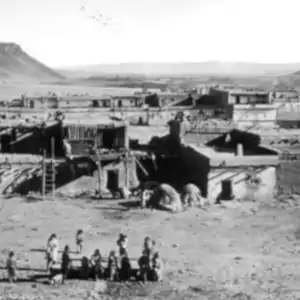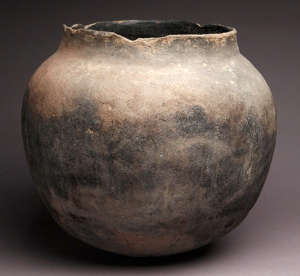San Felipe Pueblo
- Katishtya
- Language: Keres
- Size: About 49,000 acres
- Population: 3,185
San Felipe is probably the most culturally conservative of the Keres-speaking pueblos.
Coronado most likely visited San Felipe in 1540 as he passed through searching for gold. The Spanish came back in force and stayed in 1598. At that time, there were two main San Felipe pueblos, one on each side of the Rio Grande. The main villages consisted of two-and-three-story apartment-style dwellings plus about 200 individual homes. The first mission church was built in the eastern village in 1600.
The people of San Felipe participated in the Pueblo Revolt of 1680 but no Spaniards were killed there. There was also no resident priest in San Felipe. While the Indians were busy sacking the church, the Spanish settlers in the area quietly got away to Isleta. When the Spanish returned in 1681, the San Felipe abandoned their pueblo and took refuge atop Horn Mesa (southwest of Cochiti Pueblo). The Spaniards looted and burned the pueblo before retreating south again. In 1692 when Don Diego de Vargas arrived at the head of (what looked like) Spanish military troops, the people of San Felipe agreed to return to their village and be baptised. At first they moved to the top of Santa Ana Mesa but in 1696, they came down from the mesa and founded the modern pueblo. In those days the San Felipe were relatively friendly with the Spanish and that alienated them from the other pueblos.
When Mexico declared its independence, Mexico also threw open the door to marauding Apaches, Comanches and Navajos. The pueblos in New Mexico were unprotected, both from the nomadic raiders and from the corrupt politicians and judiciary. American control of the area didn't change that until they finally subjugated the nomadic Utes, Apaches and Navajos in the 1860s. But that didn't stop the politicians or the judiciary from working hand-in-glove with various land speculators seeking to steal pueblo land. That was when it came clear that the rights granted to owners of Spanish and Mexican Land Grants by Congress had precedence over the rights granted any Indian tribe through any treaty or other contractual agreement. Part of the problem as it related to San Felipe is that San Felipe was granted more arable land per person than any of the other pueblos. Finally, Congress in 1924 passed the Pueblo Lands Act and has taken further action since to guarantee the Pueblos their sovereignty and control of their own land. To this day San Felipe is known primarily for its agricultural products.
Pottery History

San Felipe Pueblo East in 1879

A historic San Felipe cooking jar
Unknown artist, circa 1880-1890
Because the people of San Felipe have kept so much to themselves over the years, little is known about the internal workings of the pottery tradition in the pueblo. Conversations with San Felipe potters have pointed out that the cultural conservatism is, in some respects, ending numerous of the people's long-time cultural activities as so little old knowledge is being passed down from tribal elders. Most active potters in the pueblo are either self-taught or went off-pueblo to learn their craft because almost no one teaches it in the pueblo. That has led to an active experimentation with styles and designs.
Historically, San Felipe always found it easier to trade agricultural products for pottery made elsewhere. The Zia were especially good with pottery and always short of food so bits and pieces of their wares are still found all over Pueblo country. Prior to 1700 there was a regular flow of pottery north to the Tewa pueblos, then after 1700 that flow reversed. It's also around 1700 that the Spanish stopped all native access to the lead/silver ore sources that the Cochiti, Santo Domingo and San Felipe potters had been using for paints to decorate their pots. With that, pottery making in the pueblo reverted to simple shapes made and polished out of base clay. Their design tradition disappeared and there were no attempts to revive it until very recently. With advanced pottery being readily available, the people of San Felipe focused more on their agricultural developments than on their ceramic developments. To that point, it is hard today to find usable clay for pottery-making on the pueblo lands as so few remember where the clay is and fewer yet will share that knowledge.
Lower left photo courtesy School for Advanced Research: IAF.334. Photograph by Addison Doty